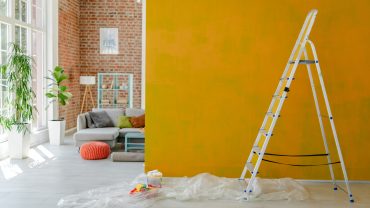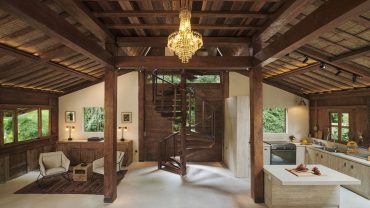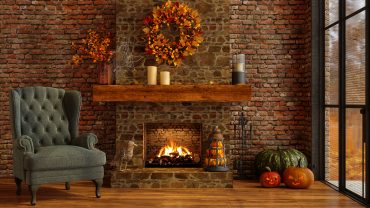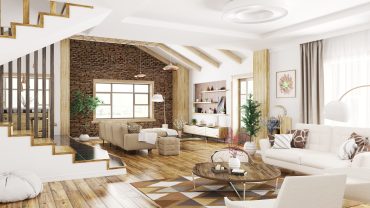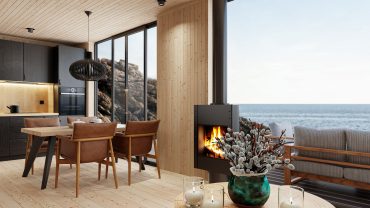In the ever-evolving world of home decor, one style continues to capture the hearts of design enthusiasts and novices alike: transitional interior design.
This design philosophy is a harmonious blend of traditional elegance and contemporary simplicity, creating spaces that are timeless, comfortable, and inviting. But what is transitional interior design exactly? Let’s dive into the nuances of this popular style, exploring its elements, transitional furniture style, and how it differs from contemporary design.
What is Transitional Interior Design?

Living room featuring transitional interior design (Credit: CreativaStudio via Getty Images)
Transitional interior design is the art of marrying classic design elements with modern trends to create a cohesive and balanced aesthetic. It’s about finding the sweet spot between the warmth and intricacy of traditional styles and the cool, minimalistic approach of modern design. This fusion creates a versatile and neutral space that appeals to a wide range of tastes.
Transitional Furniture Style and Other Elements

A modern styled living room (Credit: gremlin via Getty Images)
The transitional style is characterised by a neutral colour palette, which lays a calming foundation for the entire space. Soft, muted shades like beige, taupe, and grey dominate, allowing for flexibility in mixing and matching decor elements. In transitional furniture style, the lines are clean yet sophisticated, blending straight lines with gentle curves to strike a perfect balance. This furniture often serves as a statement piece, bridging the gap between old and new.
Textures and materials play a crucial role in adding depth and interest to transitional interior decor. The juxtaposition of soft upholstery with hard, glossy finishes introduces a tactile dimension that’s both luxurious and understated. Layering lighting fixtures, from modern pendants to classic table lamps, further enhances the ambiance, creating a warm, inviting glow that highlights the room’s best features.
Transitional Interior Design in Practice

Transitional styled, cosy living room interior. (Credit: imaginima via Getty Images)
In practice, the transitional look encompasses a careful selection of furniture and decor that embodies both modern and traditional elements. Its foundation is a neutral colour scheme for the walls and large furniture pieces, providing a versatile backdrop for layering different styles. Transitional furniture meanwhile tends towards clean lines but with a nod to traditional detailing, such as tufting or subtle wood trim.
Mixing decorative elements is key to transitional decor, combining modern art pieces with vintage accessories to add personality and depth. And textiles like rugs and throw pillows complement the furniture’s neutral tones, introducing texture and subtle patterns without overwhelming the space. This careful curation of old and new creates a dynamic yet harmonious interior.
Transitional Interior Decor in Different Spaces

Comfortable transitional bedroom in luxurious apartment. (Credit: alvarez via Getty Images)
Transitional interior design shines in its ability to adapt to various rooms, from the living room to the bedroom, kitchen, and bathroom. In living spaces, a large, plush sofa in a neutral fabric can be accented with chairs featuring more pronounced lines and metal or glass tables to introduce a modern edge. Bedrooms can incorporate the soft, inviting nature of transitional decor, blending intricately upholstered headboards with crisp, clean bedding that invites relaxation.
When it comes to kitchens and bathrooms, cabinetry and fixtures may blend sleek lines with classic forms. For example, shaker-style cabinets painted in a soft grey paired with modern hardware can create a kitchen that feels both fresh and timeless. In bathrooms, freestanding tubs with contemporary fixtures against a backdrop of classic subway tile are one example of the transitional balance.
Transitional Design Challenges

Transitional kitchen design with green featured kitchen elements. (Credit: alvarez via Getty Images)
While transitional interior design offers flexibility, its subtle blend of old and new must be carefully considered. For instance, overcrowding spaces with too many disparate elements can create a confused and cluttered look. Thus, it’s a matter of regarding all the furniture and decor as a whole as well as individually.
Then there’s the importance of the neutral colour palette. These soft, understated hues are crucial in tying the different styles together, creating a cohesive and tranquil environment. Finally, the transitional style is about harmony and balance; overly favouring either traditional or modern elements can tilt the scale, losing the essence of transitional decor.
Transitional Design Versus Contemporary

Fully furnished interior of a transitional living room. (Credit: alvarez via Getty Images)
Transitional interior decor is often confused or even conflated with its close cousin, contemporary interior design. Both are flexible styles that incorporate elements from their more strictly defined counterparts. They also share an affinity for a neutral palate. But there are several differences, including:
Furniture and Form
Transitional furniture merges traditional comfort with the sleek lines of modern design, offering a balanced, adaptable look. In contrast, contemporary furniture emphasises form and function, with innovative materials and shapes defining the space.
Decorative Elements
Transitional decor relies on a mix of old and new to achieve its signature balanced aesthetic, incorporating texture and subtle patterns through textiles and accessories. Contemporary design, however, leans towards minimalism, with fewer decorative items and a focus on open, uncluttered spaces.
Flexibility
Transitional interior design’s greatest strength lies in its flexibility and timelessness, effortlessly adapting to personal tastes and evolving trends. By contrast, contemporary design tends to shift with the trends of the moment.
The Future of Transitional Decor

A luxury living room, styled in transitional interior design. (Credit: Gokcemim via Getty Images)
As we look to the future, transitional interior design continues to evolve, influenced by emerging trends and the growing emphasis on sustainability and technology. Yet, its core principle of balance remains unchanged. Designers predict that the style will lean towards incorporating more sustainable materials and smart home features, further blending tradition with innovation.
Summarising Transitional Interior Design

Transitional interior design of a living room with a yellow sofa and beige armchairs. (Credit: Scovad via Getty Images)
Overall, transitional interior design offers a flexible and enduring approach to creating beautiful, harmonious living spaces. But more than that, it is both modern and timeless, a unique design style all of its own.




